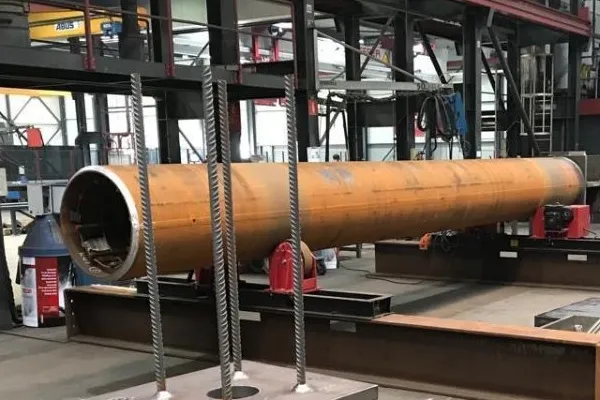When choosing steel pipes for transporting oil and gas, building structural engineering or offshore construction, many people hesitate between DSAW and LSAW steel pipes. Although these two types of steel pipes look similar, both are welded with submerged arc welding technology, with high strength and good quality, but in fact there are many differences in production methods, structural characteristics and application occasions. This article will help you understand the difference between them and help you choose the one that best suits your project.
What is a DSAW Pipe?
A DSAW (Double Submerged Arc Welded) pipe refers to a steel pipe welded on both the interior and exterior surfaces using submerged arc welding. DSAW pipes can be either straight-seam or spiral-welded. Compared to traditional single-weld pipes, DSAW pipes offer stronger welds and superior sealing capabilities.
Key characteristics of DSAW pipes include:
Double-sided welding enhances weld density and strength;
Suitable for large-diameter, thick-walled pipes, with diameters up to 1500mm;
Uniform welds and stable structure, ideal for high-pressure, high-flow applications;
Commonly used in bridge piling, dredging, low-pressure oil and gas pipelines, and water infrastructure.
It is important to note that DSAW refers to the welding method, not the forming method, and can be applied to both longitudinal and spiral-formed pipes.
LSAW pipes are created by forming steel plates into a cylindrical shape and welding them along a longitudinal seam using submerged arc welding. Common forming processes include UOE (U-forming, O-forming, and Expansion) and JCOE (J-forming, C-forming, O-forming, and Expansion). LSAW pipes are primarily used for high-pressure, high-strength applications, offering excellent dimensional accuracy and corrosion resistance.
Key Features of LSAW Pipes:
Single longitudinal seam with internal and external passes
High forming precision with excellent straightness and roundness
Used in long-distance pipelines, offshore platforms, and high-pressure gas pipelines
Ideal for applications requiring high strength and superior quality control
Differences Between DSAW and LSAW Pipes
While both belong to the category of submerged arc welded pipes, several distinctions exist:
Welding Method
DSAW pipes use double-sided submerged arc welding, while LSAW pipes are welded along a single longitudinal seam with both internal and external passes.
Forming Method
DSAW pipes can be longitudinal or spiral-formed, while LSAW pipes are always longitudinal (straight-seam) formed, ensuring high straightness and concentricity.
Diameter & Wall Thickness
DSAW pipes are more suitable for larger diameters (greater than 1000mm) and thicker walls (up to 50mm). LSAW pipes are typically used for medium to large diameters, with wall thickness up to 40mm.
Applications
DSAW pipes are commonly used in cost-sensitive projects such as piling and drainage systems, while LSAW pipes are more suited for high-pressure, high-spec applications like gas pipelines.
Weld Length
DSAW pipes, especially in spiral form, have longer welds, potentially resulting in more failure points. LSAW pipes have shorter welds, which helps improve overall pipe reliability.
Difference between DSAW and LSAW production processes
DSAW (Double Submerged Arc Welded) Steel Pipes and LSAW (Longitudinal Submerged Arc Welded) Steel Pipes differ primarily in the forming process and welding methods used during production.
Forming and Welding Process: DSAW pipes are typically produced by welding a steel plate into a cylindrical shape, utilizing double submerged arc welding on both the inside and outside seams. The process involves rolling a steel plate into a tube and then welding both edges using submerged arc welding. The DSAW process is suitable for large-diameter pipes but tends to be quicker and more flexible in terms of material usage, allowing for a range of pipe sizes. In contrast, LSAW pipes are made by bending steel plates into a U-shape and then into an O-shape, followed by double submerged arc welding along the longitudinal seam. LSAW pipes are often made using specific forming methods like UOE, JCO, or RB, providing higher precision and weld integrity.
Strength, Applications, and Cost: DSAW pipes are typically used in large-diameter pipelines, primarily for lower-pressure applications. The process is more cost-effective and faster, making DSAW pipes ideal for projects where speed and cost are priorities. However, they may not be as strong or precise as LSAW pipes. LSAW pipes, on the other hand, are used in more demanding applications, including high-pressure and high-strength requirements such as offshore oil and gas pipelines. The LSAW process provides better structural integrity, a smoother surface finish, and superior dimensional accuracy, but it comes with a higher production cost. Therefore, LSAW pipes are more suited for critical infrastructure where higher performance and reliability are necessary.
Standards and Certifications
Both DSAW and LSAW pipes can be manufactured in accordance with international standards such as:
API 5L – Specification for line pipes used in oil and gas transmission;
ISO 3183 – International standard for petroleum and natural gas industries;
EN 10219/EN 10210 – European standards for structural steel tubes.
For high-standard projects, such as API 5L PSL2 pipelines or sour service conditions, LSAW pipes are generally preferred due to their higher dimensional accuracy and superior corrosion resistance.

Conclusion
When selecting between DSAW and LSAW steel pipes, consider the following principles:
Choose DSAW pipes when your project prioritizes cost-efficiency, weld strength, and structural stability for large-diameter, low-pressure applications;
Opt for LSAW pipes when dimensional accuracy, service life, and performance in challenging conditions are critical factors.
For projects involving API standards, long-distance transmission, or offshore construction, LSAW pipes are the superior choice. On the other hand, for infrastructure works like bridge piling or urban drainage, DSAW pipes provide a more economical solution.
If you need additional technical support or specification advice during project planning or procurement, please consult
BAOWI Steel. As a leading steel pipe manufacturer, BAOWI Steel is committed to providing customers with high-quality steel pipe products and professional technical support to ensure that your engineering needs and economic benefits are met.






 English
English Español
Español بالعربية
بالعربية











 Phone :
Phone :  Whatsapp :
Whatsapp :  Email :
Email : 


